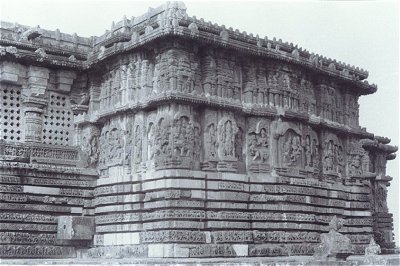Hoysala Style Temples
by K. L. Kamat
Date: July 15, 1999
Page Last Updated: December 07, 2024
The Hoysala dynasty from the 11th century lasted for two hundred and fifty years. They developed sculptural and architectural styles which were radically different than what was in existence. The temple scheme is repeated in multiples of two and three. The plinth and sanctum (vimana) are star (stellate) shaped. A wide pathway runs around the temple on the outside for ritual circumambulating (pradaskshina). The tower ( shikhara) is subdued by horizontal lines and moldings. It has also miniature sculptured shrines, fretted string courses and moldings. The stellate plan of the temple contributes to a greater variety of light and shade.
The prayer hall (navaranga) is divided into two layers, while the vimana is in three layers. In both a multi-tiered external facade, nine to ten feet high, runs along the stellate course of the plan. Its exuberant display of fluid art is remarkable. The fantastic amount of patient work that went into the carvings can be barely conceived from the simple fact that the multi-tiered frieze along the basement extends five to seven hundred feet in length along the sinuosities of the stellate plan.
K.L. Kamat/Kamat's Potpourri
Example of Hoysala Temple
The carved bands are ranked in a fixed, conventional order. The lowest tier is an endless defile of elephants, denoting strength and stability. Next comes a row of leogriffs (shardulas), which represented the emblem of the Hoysalas and convey valor. Above this is a tier of spiral foliage of exquisite design and workmanship. Conveniently located at eye-level is a panorama of the Hindu epics, a retelling in stone of various stories in a wealth of detail. Above this is a tier of spiral-spouting hippogriffs (yalis), symbolizing the sacred river Ganges. Crowning all is a running pattern of geese (hamsa), which according to legend, swim in the waters of the minds of the great. The intermediate space is being filled by perforated stone screens known as jalandras.
The central space of the vimana is occupied by a frieze of minutely wrought representations of deities and damsels, splendidly appareled and bejeweled. Each figure stands half life-size. The Hindu pantheon is extensively and graphically represented, completed with all the accessories, attributes and symbols of each celestial being. Lord Shiva is with his consort Parvati. Ganesh, the elephant-God; Brahma, the creator; Varaha, the boar-God; Krishna, the cowherd-God; Indra, the rain God, all are depicted. The fascinating picture gallery in stone winds several hundred feet around the vimana. The Hoysala sculptors have used soap stones (chlorite schist) for their craft. These stones are easy to work with chisel, harden with exposure, and have retained their gloss after a lapse of eight centuries.
Every part of these temples exhibits a joyous exuberance of fancy, scorning mechanical refrain. All that is wild in human faith or warm in feelings is found portrayed in these temples. As a monument of the phenomenal concentration, super technical skill, ingenuity, imagination, and profound religious consciousness of those concerned in their creation, there is no parallel to these anywhere in the world.
![]()
See Also:
-
Kamat PictureSearch Results for Hoysala
|
Temples of Belur and Halebidu in Karnataka |

